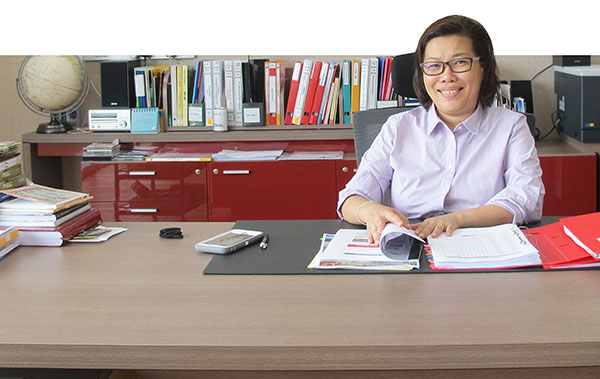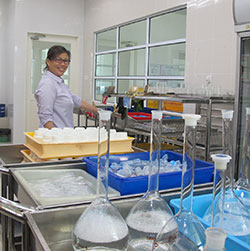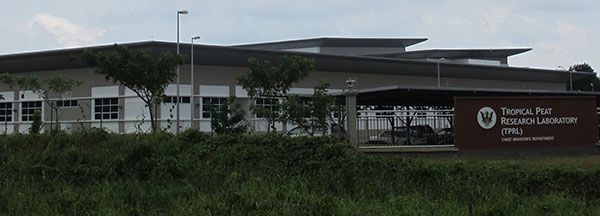
ORGANISING an international scientific forum such as the 15th International Peat Congress (IPC) in Kuching is no child’s play but Tropical Peat Research Laboratory (TPRL) director Dr Lulie Melling is taking it all in her stride.
In her role as IPC congress general, she is determined to make the event happen in the state capital (from Aug 15 – 19) not to add to her own list of achievements but rather, for the good of Sarawak.
Such a scientific global congress will put the state on the world map. Moreover, it will give local organisers the opportunity for exposure to international event management, and local researchers the platform to share their findings, especially on tropical peat management, where Sarawak does have locus standi as it is spearheading research and studies on the subject in Southeast Asia.
What made Lulie so keen to bring the congress to Kuching is the fact that oil palm industry players are thirsting for knowledge on viable oil palm cultivation on peatland — a concern that is frequently overlooked.
Despite her tight schedule, Lulie found time to talk to thesundaypost on the importance of research and development (R&D) as well as the sustainable development of peatland for the oil palm industry.
How would you comment on research development in Sarawak?
It’s a bit slow due to the low population, the low income and the lower standard of education compared to developed countries.
To have sound research development, there must be two criteria — research capacity and funding. Even when both criteria are met, not many would go into research because research means passion, determination, commitment as well as long working hours. What makes it worse is that there is not much monetary returns.
We do have some research in Sarawak but it’s not grounded enough yet to put us on the world map. Research development in Sarawak has still a long way to go. For those interested, funding is necessary.
This is the area where we need much help and participation from the government. Presently, among the institutions or establishments in Sarawak which have their own research units, TPRL still has the highest citation.
How can Sarawak be more involved in research and development?
We have to start with the schools to create awareness. We have found that some of our graduates are interested in research but there is a general lack of understanding about what is actually going on.
Some may try to go for research in medical fields.
The truth is we don’t have that capacity yet in Malaysia. Even Singapore is struggling with medical research. It’s just too expensive and we don’t have the capacity.
So for those researchers with biology-related qualifications, we should encourage them to go for oil palm and other associated studies as the state has available resources.
A lot of research needs to be done in Sarawak, especially on agriculture. This is of paramount importance. A country’s success depends to a large extent on its research programmes or progression.
Now, the state is relying a lot on palm oil production for revenue. If I’m not mistaken, palm oil has taken over timber as the main revenue earner. So a lot of production research is needed on oil palm, especially in the areas of breeding, pests and diseases and agronomy — which we don’t have.
It’s the economic in-thing now and we do need researchers in these fields. Since TPRL already has the infrastructure for it, we can help researchers kick-start their work.
TPRL understands the need to get our children and young people started early. So after this congress, we will be going to the schools and universities to promote research and development in the relevant areas. Right now, no one in the state is doing this.

Dr Lulie inside the cleaning room of TPRL.
Why do you think peat research is important to Sarawak?
Peatland is the last frontier of arable land in Sarawak and Malaysia. It used to be known as wasteland but our research has
been able to turn the once unproductive peatland into a valuable resource for Sarawak. Properly managed, peatland, like any other soil types, becomes land suitable for industrial agriculture development.
Peatland has thus become an important resource for Sarawakians, especially the rural communities. There are many rural farmers who, after involving in small-scale oil palm planting, are now able to generate income to send their children for tertiary education locally or even overseas.
With the depletion of the timber industry, the oil palm industry has taken over as the biggest income earner for the state. So peat research is of paramount importance. The more we know about peat, the more effective we can be in managing it, especially its sustainability.
Is there adequate funding for R&D in peatland development in Sarawak?
Given the urgency for such an important undertaking, we consider the funding inadequate because we need money to pay for contract workers and researchers to carry out studies at our lab.
At the same time, however, we have to remember we at TPRL have the organisational capacity. In that sense, I would say ‘yes’ because I have the support of this complex (TPRL Complex).
The other thing I don’t have enough of is research capacity. That’s why I need a lot of funding for the researchers to go for higher learning.
You are a pioneer of tropical peatland research. How did you get started?
I have made a life commitment to do research because I like research. It is unlimited exploration and has a lot of freedom.
I went into peat because I saw the problems in peatland development. I didn’t want Sarawak to be like a savannah where all the peat swamp forests ended up as grasslands.
In Indonesia, the peat swamp forests which turned into grasslands are called ‘gambut terlantar’ — and these are the ones that cause peat fires.
In Miri, there is also an area with peat fire problems. Even if there is a water table under the peatland, peat fires will occur because porosity of surface water is very high.
When the government came up with a policy to develop oil palm, I delved further into oil palm on peatland as I could see that the crop is very important to the state economy. All this while, I must say my involvement in peat research has been voluntary. Presently, TPRL’s main area of research is improvement on production through efficient peatland management. While we improve production, we also try to improve the sustainability aspect.
International criticisms are such that when you develop peatland, you destroy the eco-system of the peatland. Any comments?
That’s the (in)famous NGO statement. Actually, it also applies to development of any land with any vegetation except that we get a bit more sensitive when it comes to peatland. Do you call developing land for agriculture destroying the ecosystem — when it’s for food production?
When we ameliorate our land into oil palm plantation, does it change or degrade the ecosystem?
Actually, it improves the ecosystem. Of course, there is a discount — from virgin land to non-virgin land. But the salient question is how much is the discount? The amelioration does not destroy the land. With the advancement of science and technology, we are able to
improve land which was once wasteland. And oil palm, being a perennial crop, makes an oil palm plantation almost similar to a forest. This is important because the natural forest itself is not enough to sustain the increasing population or the state’s economy.
Yes, a responsible government needs to balance conservation and development. But what some western NGOs want is for our forests or peatlands to be totally untouched. Our forests would then be just like a museum.
They start using the word ‘destroy’ or ‘degrade’ even when the forests are utilised for agricultural purposes.
It’s a way to block us from progressing. It is also a way to put up barriers to protect the oil seeds from Europe. You have to look at it from the bigger picture.
Our problem is that we don’t develop a deep understanding of the subject — that’s why in the face of their attacks, there is nothing much we can say in defence.
As researchers, we work in line with government policies. We do research to ameliorate the land to make sure the industry can continue to progress and the country can continue to benefit from the industry.
Research is just a tool to a better future. We are not that irresponsible as to destroy our land and our natural resources. We acknowledge the importance of sustainability.
The development of the oil palm industry in Sarawak is a key area to push the country forward economically. Every country
goes through the same process. Europe went through the agriculture age before the industrial revolution.
We need to develop our agriculture in order to have capital for research capacity and
nation-building. In developing our natural resources, we have to take lessons from the West in terms of balancing conservation and development.
The Sarawak government acknowledges the importance of research and has taken the initiative to build a well-equipped research lab as exemplified by the TPRL Complex.
With the availability of basic infrastructure, what we need now is the involvement of industry players — for them to work together to support research funding or scholarships to train up more scientists.

TPRL is a research unit under the Chief Minister’s Department.
Compared to international research, how advanced do you think our peatland research is?
In general, the West is more advanced in research. However, temperate peat, boreal peat and tropical peat are all different. In tropical peatland research, we are ahead because peatland is at our doorstep.
For the upcoming International Peat Congress themed ‘Peatlands in Harmony: Agriculture, Industry and Nature’, about 25 per cent of the research papers from Malaysia will be contributed by TPRL.
We understand you are organising the International Peat Congress (IPC) in Kuching. Can you tell us more about it?
This is the first time this congress is convened outside Europe and North America in the 60-year history of the International Peat Society.
IPC provides a lifetime opportunity to attend and benefit from scientific, industrial and governmental discussions, at the same time, forming research partnerships and cooperation with international institutions.
This congress brings together the leading professionals from all corners of the world to take stock of the present state of knowledge and experiences, bring forth future challenges and shape the agenda to advance the development of global peatlands.
There will be more than 500 abstracts for both oral and poster presentations. Participants from 38 countries — and still counting — will be attending.
This congress has created history. We are supported by two unions — IUFRO (International Union of Forest Research Organisation) and IUSS (International Union of Soil Science).
The unions will verify what we are doing is scientifically correct. Their support also accords respect to the standards of the work we are doing. No unions had supported this congress before.
IPC is held in collaboration with Indonesia. This is the best Congress you could have in the last 10 years in Southeast Asia — and also the cheapest because we want as many people to benefit from it as possible.
It can serve as a springboard towards the study of global issues related to the industry.
What can be expected from IPC?
This congress will be different. An overseas forum of this nature is usually for updating information and networking. But when held in our part of the world, it will be different.
We will not replicate what the West is doing because we have cultural differences. In other congresses, if 500 papers are submitted, you get 600 participants because they come to only update and network.
For IPC, if 500 papers are submitted, you can expect at least 1,000 participants.
This Congress will also see many from the government and the industry in attendance.
The government serves as a platform for better understanding of peatlands and the concomitant global issues. At the same time, it provides an opportunity for the study of international communications.
For practitioners from the oil palm and tree plantation industry who are dealing with peatlands on daily basis, they will be searching for more information on sustainable development of oil palm and tree plantations on peatlands. Well aware of their responsibilities, they will be keen to learn how to do it right.
